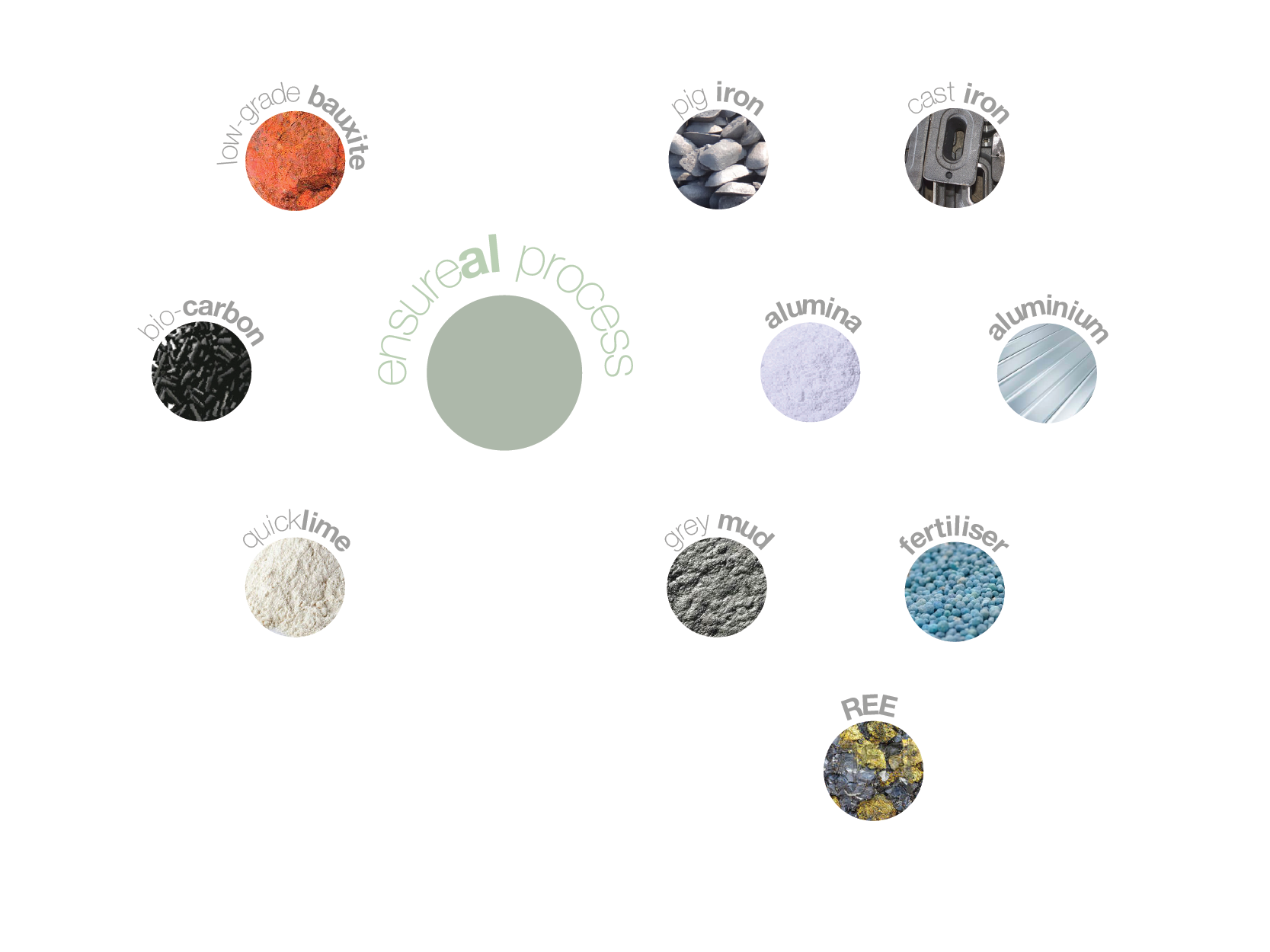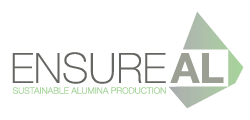The goal of ENSUREAL is to ensure zero waste production of alumina in Europe.
This will be done by developing a zero-waste process for alumina production that can handle a wider range of bauxite than the existing process. This new process will minimize the environmental impact of bauxite mining and alumina production.
Secondary objectives
- Assess, test and control the usage of biocarbon for the reduction process;
- Assess, test and control pre-reduction of European bauxite before smelting process;
- Assess, as only an extra the improvement potential of the smelting process by addition of red mud and low quality bauxite. The whole process stability will be evaluated through chosen Key Performance Indicators (KPI) and a Life Cycle Analysis (LCA), to confirm zero CO2 emission and the improvement of the yield. The processes will be initially validated in laboratory scale at kilogram scale, and then it will be demonstrated in real industrial setting at AoG. Production of at least 10 ton of slag is expected
- Assess, test and control the leaching (milling, digestion, clarification, precipitation) of the calcium aluminate slag;
- Assess, test and control the novel fluidized bed calcination process. Processes will initially be validated in laboratory scale, and then it will be demonstrated in industrial setting at AoG and OT. Production of at least 50 kg of unhydrated alumina is expected. The whole process stability will be evaluated through chosen KPI and a LCA, to confirm the improvement of the yield.
- Alumina testing: The quality of the produced unhydrated alumina will be checked against the production 2 standards of AoG for use in a Hall-Heroult aluminium smelter
- Iron testing: At least 200 kg pig-iron will be produced. Quality will be checked to further application in the European foundry industry at the Odlewnie foundry.
- Grey mud testing: The grey mud is a non-toxic CaCO3 rich product that can be utilized as raw material in cement production, in agriculture or as filler material in advanced materials. The goal is to confirm the suitability for these applications and show that this grey mud is not an environmental problem like the red mud that is produced from the Bayer process.
The European bauxite ores are relatively rich in REE and Sc, which until this day accumulate in the respective Bauxite Residues. In ENSUREAL, REE/Sc ions are leached from the calcium aluminate slag with conventional and innovative reagents to form dilute pregnant liquid solution (PLS) with 100-300 mg/L REE. The pregnant solution after leaching (dependent on the amount and the type of metal impurities) will initially be purified through differential precipitation and then the REEs as well as Sc will be precipitated as hydroxides or carbonates which in a subsequent calcination stage will be transformed to oxides that constitutes the final mixed REEs & Sc concentrate. The main goal of this process is the final production of a mixed REEs & Sc concentrate (>20%w/w) that can be sold to a refiner for production of pure REEs and Sc.
- Physical, chemical, biological and Eco-toxicological characterization of chemicals used;
- LCA and Life Cycle Cost analysis of technologies under application scales for mass flows and production processes;
- Cost and techno-economic assessment of developed technologies through the presentation of a business case and exploitation strategy;
- Social Acceptance through appropriate communication activities. The identified bottlenecks and knowledge gap in the supply chain will be found and highlighted through this process evaluation.
- Pointing out the increase in European bauxite reserve when applying the ENSUREAL process through mapping the European conventional but also poor/alternative bauxite and lime resources that can be used for the ENSUREAL process;
- Develop a roadmap for further industrialisation;
- Disseminate and communicate with current and past H2020 initiatives and consortiums. Essentially, within the SC5-15, 16 and 17 global clustering initiatives of 2016 and 2017; If suitable, integrate results of launched H2020 projects.
Breakthrough aspects

The ENSUREAL process will be able to process a wider range of bauxite qualities (high in Fe and Ca, low in Al), including qualities that, with today’s mining practice are tailings

The ENSUREAL process will not produce any waste thereby having a 100% yield in bauxite ore exploitation, and avoiding the bauxite residue disposal problem altogether

ENSUREAL puts together different industrial sectors to demonstrate a new cross-sectorial value chain, namely: aluminium, iron, agriculture and lime
In short
more products from the mined bauxite
no process residue
great flexibility raw materials
lower energy consumption
lower CO2 emissions
Improvements of the Pedersen Process
The ambition of the ENSUREAL project is to demonstrate that a modified version of the Pedersen process can produce alumina from a wide range of minerals while not producing any waste materials. The following innovations from the original Pedersen process will be implemented,
PYROMETALLURGICAL STEP
For the iron production:
- Use of Clean/alternative carbon sources
- Pre-reduction heating of the feedstock material to improve energy efficiency
- Use of advanced Electric Arc Furnace technology
HYDROMETALLURGICAL PROCESSING
For the alumina production:
- Novel alumina precipitation technology leading to improved products
- Novel alumina calcination technology with improved energy efficiency
–
For the grey mud residue:
- REE/Sc extraction
- Development of multiple utilization strategies (agriculture, construction and fillers for polymers)
Compared to the established Bayer process for alumina production, the ENSUREAL process will increase alumina production yield by 15 percentile points and reduce energy consumption by 5.4 GJ/t of alumina associated with the heat demand in the Bayer circle (53% of the total energy demand in the AoG Alumina refinery plant).
ENSUREAL value chain

